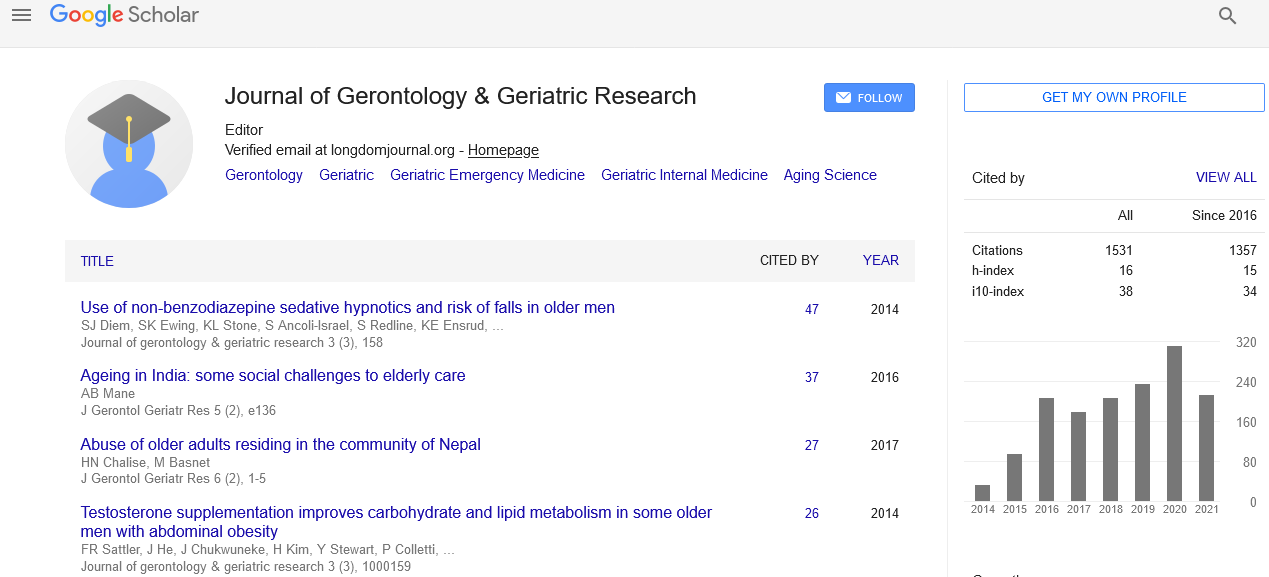PMC/PubMed Indexed Articles
Indexed In
- Open J Gate
- Genamics JournalSeek
- SafetyLit
- RefSeek
- Hamdard University
- EBSCO A-Z
- OCLC- WorldCat
- Publons
- Geneva Foundation for Medical Education and Research
- Euro Pub
- Google Scholar
Useful Links
Share This Page
Journal Flyer

Open Access Journals
- Agri and Aquaculture
- Biochemistry
- Bioinformatics & Systems Biology
- Business & Management
- Chemistry
- Clinical Sciences
- Engineering
- Food & Nutrition
- General Science
- Genetics & Molecular Biology
- Immunology & Microbiology
- Medical Sciences
- Neuroscience & Psychology
- Nursing & Health Care
- Pharmaceutical Sciences
Vascular aging and melatonin beneficial effects
International Conference on Geriatrics & Gerontology
July 08-10, 2014 DoubleTree by Hilton Hotel Chicago-North Shore Conference Center, USA
Rita Rezzani, Favero G, Franceschetti L and Rodella L F
Accepted Abstracts: J Gerontol Geriat Res
Abstract:
In the last decades the worldwide population has exhibited an increasing life expectancy with a consequent rise in the elderly population; the increase of human life expectation has important health and socioeconomic consequences. The ageassociated infirmities that accompany increased life expectancy involve cardiovascular diseases, which include diabetes, stroke, heart attack, heart failure, hypertension and neurodegenerative disease. Melatonin, the pineal indoleamine, shows remarkable function versatility exhibiting antioxidant, oncostatic, immunomodulatory and anti-aging properties. The aim of this study was to investigate parameters such as morphological alterations, inflammation and oxidative stress at the aorta level of an animal model of senescence and the effects of chronic administration of melatonin. Twenty male senesce prone mice (SAMP8) and twenty control mice, senescence resistant mice (SAMR1), were analyzed untreated or after chronic treatment with melatonin at the dose of 10 mg/kg/day in the drinking water from the 1st to the 10th month of age. The results showed that aging induced a significative increase of tunica media thickness in the aorta. In addition, we showed an increase in endothelin-1 expression and of inflammation and oxidative stress parameters compared to control mice (SAMR1). Melatonin chronic administration partially ameliorated all these age-related alterations. In summary, this study support the existence of inflammatory and oxidative stress processes during aging and suggest that melatonin behaves as an essential indoleamine against aging, for its antinfiammatory properties together with its antioxidant role.
Biography :
Rita Rezzani is Full Professor of Human Anatomy and Chair of Anatomy and Physiopathology Section at University of Brescia (Italy). Her scientific fields regard the immunosuppressive effects of cyclosporine A, the oxidative stress and the morphological alterations induced by cardiovascular diseases. Recently her interest involves the beneficial effect of natural antioxidants, in particular of melatonin, in several diseases. She is interested to study both the therapeutic and protective melatonin effects. She is author of 180 full-length publications and she participated to write several books.


